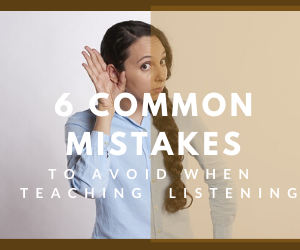Category: Teaching
Listening is the ability to identify and understand what others are saying. This involves understanding a speaker’s accent or pronunciation, his grammar and his vocabulary. The more listening practice you get, the better you understand the language. Students who lack proper listening skills will struggle to communicate with other people.
Here are the top five most common mistakes teachers make when they are teaching listening:
Here are the top five most common mistakes teachers make when they are teaching listening:
1. You didn’t check the equipment before the listening activity
Teachers should arrive in their classroom before the students to prepare any materials and equipment. As class begins on time and when students perceive that there is no time to waste, they will feel a sense of purpose.
Teachers should arrive in their classroom before the students to prepare any materials and equipment. As class begins on time and when students perceive that there is no time to waste, they will feel a sense of purpose.
2. You didn’t use a pre-listening activity
The purpose of the pre-listening activity is to prepare students for listening, to ensure student success, and to get students excited about listening.
The purpose of the pre-listening activity is to prepare students for listening, to ensure student success, and to get students excited about listening.
There are 3 ways to pre-listen
|
Option 1: Think-About: Here is where we want to activate our students’ prior knowledge.
Sample activities:
|
Option 2: Vocabulary: Give students the new words to be listening for
Option 3: Predicting: It involves thinking ahead and anticipating information or events
3. You didn’t make sure students understand the instructions
If directions or instructions are not effectively and clearly formulated, there will be a number of students who will simply not have assimilated what is to be done during the listening activity.
There are two general rules for telling what students need to do:
If directions or instructions are not effectively and clearly formulated, there will be a number of students who will simply not have assimilated what is to be done during the listening activity.
There are two general rules for telling what students need to do:
- Keep the instructions as simple as possible within the limits of the language which the students can understand. Also, think about the speed of your speech.
- Explain everything chronologically, and only start building on the next step when the previous one is understood. Instructions should always be followed by a demonstration.
There are a series of activities that help students reflect on the listening experience, these are called Post-listening activities. Most of them focus on these 3 subskills:
- Listening for the gist.
- Listening for specific information.
- Listening for the speaker’s attitude or opinion.
4. You only played the listening track once
It’s vital to understand that listening to an audio several times helps students to get the most out of it and be able to get the answers.
It’s vital to understand that listening to an audio several times helps students to get the most out of it and be able to get the answers.
5. You don’t use a variety of listening material regularly
Try to use all kinds of listening materials such as monologues, conversations, interviews, radio ads, speeches, etc. Also, you can use a different range of voices such as male, female, old, young, native speaker, etc.
Try to use all kinds of listening materials such as monologues, conversations, interviews, radio ads, speeches, etc. Also, you can use a different range of voices such as male, female, old, young, native speaker, etc.
6. You didn’t use a post-listening activity
Remember that a post-listening activity represents a follow up to the listening activity and aims to use the knowledge gained from listening for the development of other skills such as speaking and writing.
Remember that a post-listening activity represents a follow up to the listening activity and aims to use the knowledge gained from listening for the development of other skills such as speaking and writing.
These activities focus on:
1. Content
Sample activities:
2. Form
Sample activities:
1. Content
Sample activities:
- Check answers.
- Discuss what they liked/didn’t like.
- Solve moral dilemmas in a round table.
- Write a short essay based on the information given.
2. Form
Sample activities:
- Identify verb forms in the audio.
- Read the transcript and make notes of common collocations.
- Find new words in the audio and find out what they mean.







